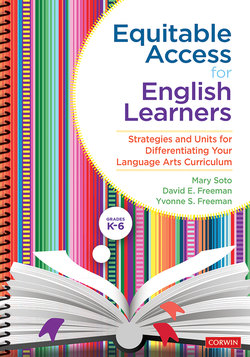Читать книгу Equitable Access for English Learners, Grades K-6 - Mary Soto - Страница 16
На сайте Литреса книга снята с продажи.
Separate EL Resource Book
ОглавлениеMost basal programs include a resource book and online resources for emergent bilinguals. In a typical program, teachers are directed to have English learners listen to a recorded version of the text selection, usually provided as an online resource before the reading lesson. The teacher then pre-teaches key vocabulary from the reading. After that, the teacher follows a script to teach the selection. First, the teacher reads the text aloud, one paragraph or short section at a time, and then stops after each paragraph or section and asks a series of questions to guide students through the reading. This plan for supporting English learners is teacher centered rather than student centered and seldom engages students in meaningful language use. Further, there is no attempt to shift the responsibility from the teacher to the students. Instruction should help emergent bilinguals develop the skills needed to become independent readers.
Basal program teacher scripts are designed to present some background or context for the reading, define key vocabulary, and build understanding. Questions are often based on the pictures in the text. Teachers ask students about what they see in the picture. The resource guide provides teachers with expected answers from the students.
There are several problems to an approach that uses a question-answer script. Many of the questions teachers are supposed to ask are syntactically complex and contain vocabulary that many emergent bilinguals could not be expected to have acquired. Since language acquisition results from receiving comprehensible input, it is unlikely students would benefit from questions that are incomprehensible to them. Further, asking and answering questions is an oral exercise. Although the development of oral English is important for learning to read, during reading instruction time students should spend most of their time interacting with written text.
The question-answer format follows a traditional IRE (initiation, response, evaluation) approach to teaching that has been shown to be ineffective in promoting either language development or content knowledge. It discourages real language-rich discussions and higher-order thinking because most questions have only one answer that is found in the story selection. Another problem is that stopping to ask questions after each paragraph breaks up the reading and makes text comprehension more difficult. This IRE approach is different from a gradual release of responsibility model with read alouds, shared reading, guided reading, and independent reading that focuses on comprehension of whole texts and moves students toward reading independence.
Finally, one of the major dilemmas facing nearly every teacher is not having sufficient time to meet instructional objectives. The underlying assumption of EL activities in basals is that teachers must take extra time to implement these activities with English learners, despite the fact that teachers in mainstream classes have only limited time for teaching language arts.
Rather than using supplemental activities to meet the needs of emergent bilinguals, teachers need an approach that can be effective for both English learners and native English speakers. In this book, we describe an approach teachers can use for all their students. The strategies we describe are designed to build background; help students develop language arts skills; and actively engage students in reading, writing, and discussing key concepts as they study different inquiry units in their language arts reading programs.
In the chapters that follow, we provide four sample units of inquiry commonly found in mandated English language arts programs. For each of these units, we suggest strategies that will effectively engage and support all students, including English learners. For each strategy, we suggest Standards based skills these activities help students develop. We also include content and language objectives for different activities in each unit. These sample units of inquiry provide examples of an approach that teachers can use in language arts instruction. At the end of each chapter, we summarize the strategies used throughout the unit. We also list additional texts teachers can use to supplement the unit.
